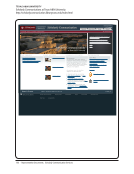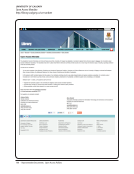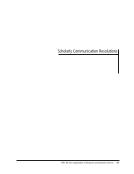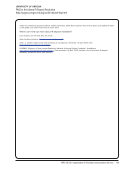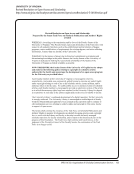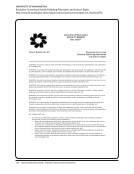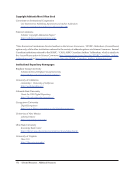SPEC Kit 332: Organization of Scholarly Communication Services · 11
Executive Summary
Introduction
Borrowing from the Washington University in St.
Louis Scholarly Communications Group’s statement
of purpose, this survey defined scholarly communica-
tion (SC) as the creation, transformation, dissemina-
tion, and preservation of knowledge related to teach-
ing, research, and scholarly endeavors. The survey
explored how research institutions are currently or-
ganizing staff to support scholarly communication
services, and whether their organizational structures
have changed since 2007. It asked respondents about
the SC services offered at their institutions, how those
services are supported and assessed, and the impacts
that SC leadership and services may have had on the
institution or larger community. Sixty of the 126 ARL
member institutions responded to the survey between
May 14 and June 12 for a response rate of 48%. Of these
respondents, 56 (93%) affirmed that their library or
institution was involved in SC services.
Scholarly Communication Leadership
All but three of these 56 respondents reported that an
individual or group in the library had primary respon-
sibility for leading organized SC efforts at their institu-
tions. When asked whether the library’s SC leadership
is considered to be the institution’s main SC leader, 37
of the 49 respondents (76%) answered yes, but several
of their comments reveal a hesitation in staking a de-
finitive leadership claim. For example, one respondent
stated that leadership roles are, “Perhaps not clear….
it’s hard to say who the ‘main leaders’ are.” Another
offered that their library has “the only dedicated of-
fice on campus, but additional units in the library….
and outside the library….also contribute.” Some of
the 12 respondents (24%) who answered that they are
not the main institutional leader had similar com-
ments. One wrote that their team “is as far as I know
the only game on campus, but not necessarily recog-
nized by the institution at large.” Another respondent
explained, “I’m not sure the institution is completely
aware of scholarly communication ‘services’.”
These comments reflect a tension between respon-
sibility and leadership that is perhaps felt by many
libraries. They also illustrate how difficult it can be
to understand institutional perceptions of SC leader-
ship. The nature of scholarly communication itself
may be one cause of the difficulty. SC encompasses
such a wide variety of activities, individuals, and
groups that identifying one leader may be impos-
sible or irrelevant. In fact, every library identified as
involved in providing SC services also collaborates
with institutional partners to support those services.
Perhaps seeking clarity about definitive leaders is the
wrong approach the best answer to the SC leadership
question may simply be that 95% of the respondents
identified their libraries as responsible for SC lead-
ership efforts, and are, therefore, SC leaders at the
institutional level.
Leadership Structure, Staffing, and Time
The survey asked respondents to select one of six op-
tions that best described their SC leadership structure.
Seventeen respondents (30%) selected a single indi-
vidual in the library as the primary leader. Fourteen
(25%) reported leadership by a library office, depart-
ment, or unit. Thirteen (23%) indicated that SC leader-
ship was distributed among two or more individuals
in the library (other than a unit or team). Nine (16%)
reported that leadership was the responsibility of a
library team, committee, or task force. The remaining
Executive Summary
Introduction
Borrowing from the Washington University in St.
Louis Scholarly Communications Group’s statement
of purpose, this survey defined scholarly communica-
tion (SC) as the creation, transformation, dissemina-
tion, and preservation of knowledge related to teach-
ing, research, and scholarly endeavors. The survey
explored how research institutions are currently or-
ganizing staff to support scholarly communication
services, and whether their organizational structures
have changed since 2007. It asked respondents about
the SC services offered at their institutions, how those
services are supported and assessed, and the impacts
that SC leadership and services may have had on the
institution or larger community. Sixty of the 126 ARL
member institutions responded to the survey between
May 14 and June 12 for a response rate of 48%. Of these
respondents, 56 (93%) affirmed that their library or
institution was involved in SC services.
Scholarly Communication Leadership
All but three of these 56 respondents reported that an
individual or group in the library had primary respon-
sibility for leading organized SC efforts at their institu-
tions. When asked whether the library’s SC leadership
is considered to be the institution’s main SC leader, 37
of the 49 respondents (76%) answered yes, but several
of their comments reveal a hesitation in staking a de-
finitive leadership claim. For example, one respondent
stated that leadership roles are, “Perhaps not clear….
it’s hard to say who the ‘main leaders’ are.” Another
offered that their library has “the only dedicated of-
fice on campus, but additional units in the library….
and outside the library….also contribute.” Some of
the 12 respondents (24%) who answered that they are
not the main institutional leader had similar com-
ments. One wrote that their team “is as far as I know
the only game on campus, but not necessarily recog-
nized by the institution at large.” Another respondent
explained, “I’m not sure the institution is completely
aware of scholarly communication ‘services’.”
These comments reflect a tension between respon-
sibility and leadership that is perhaps felt by many
libraries. They also illustrate how difficult it can be
to understand institutional perceptions of SC leader-
ship. The nature of scholarly communication itself
may be one cause of the difficulty. SC encompasses
such a wide variety of activities, individuals, and
groups that identifying one leader may be impos-
sible or irrelevant. In fact, every library identified as
involved in providing SC services also collaborates
with institutional partners to support those services.
Perhaps seeking clarity about definitive leaders is the
wrong approach the best answer to the SC leadership
question may simply be that 95% of the respondents
identified their libraries as responsible for SC lead-
ership efforts, and are, therefore, SC leaders at the
institutional level.
Leadership Structure, Staffing, and Time
The survey asked respondents to select one of six op-
tions that best described their SC leadership structure.
Seventeen respondents (30%) selected a single indi-
vidual in the library as the primary leader. Fourteen
(25%) reported leadership by a library office, depart-
ment, or unit. Thirteen (23%) indicated that SC leader-
ship was distributed among two or more individuals
in the library (other than a unit or team). Nine (16%)
reported that leadership was the responsibility of a
library team, committee, or task force. The remaining








































































































































